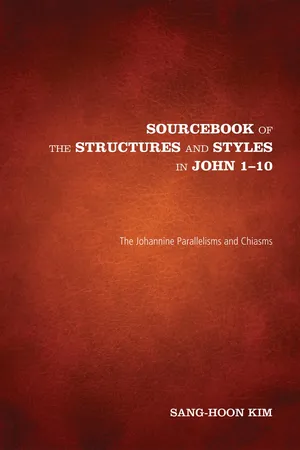
Sourcebook of the Structures and Styles in John 1-10
The Johannine Parallelisms and Chiasms
- 334 pages
- English
- ePUB (mobile friendly)
- Available on iOS & Android
About This Book
No other book in the New Testament compares to John in its complexity of style and structure. So many factors confuse Johannine scholars, including the complexity of styles, repetition, duplication, and seemingly distracted structures that are difficult to discern. Sourcebook of the Structures and Styles in John 1-10 is designed to scrutinize the structures and styles in John 1-10, reading John according to John's way, with the following integrated points of view: First, this reading is indebted to both diachronic and synchronic approaches. Second, macro structure and micro style are treated together and interactively. Third, specific and overall analyses are made together. Fourth, grammatical and relational considerations are brought together. Fifth, syntactic, semantic, and pragmatic relations are considered all together. Sixth, both parallelisms and chiasms (including their variations) are examined, whether in macro structure or in micro style, without excluding either. Seventh, all types of parallelisms and chiasms are examined, whether simple or complex. Eighth, ancient and modern ways in writing-reading processes complement each other. Ninth, Western and Eastern perspectives become complementary. Tenth, the Greek text and its English version (by the author) are used interactively. Eleventh, analysis and discussion are brought to complement one another.
Frequently asked questions
Information
The Prologue and the Early Testimonies


Table of contents
- Title Page
- Preface: A Journey in John
- Acknowledgments
- Abbreviations
- Introduction
- The Structure of John
- Chapter 1: The Prologue and the Early Testimonies
- Chapter 2: The Cana Miracle and the Cleansing of the Temple
- Chapter 3: Two Dialogues with Discourses
- Chapter 4: The Samaritans and a Royal Official
- Chapter 5: The First Sabbath Healing and the Discourse of Jesus
- Chapter 6: “I Am the Bread of Life”
- Chapter 7: Who Is He and Where Is He From?
- Chapter 8: “I Am the Light of the World,” I
- Chapter 9: “I Am the Light of the World,” II
- Chapter 10: The Shepherd and the Sheep
- Bibliography